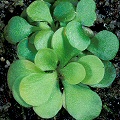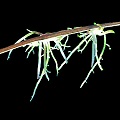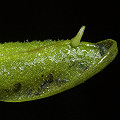Q: How do I propagate my plants by asexual reproduction?

Genlisea violacea

Drosera anglica
false vivipary

Pinguicula
leaf pullings

Utricularia praelonga
plantlets

Pinguicula primuliflora
leaf budding
A: As I noted in the previous FAQ entry on sexual reproduction, asexual
(or vegetative) reproduction means you are taking some part of the plant and
are transforming it into forming a new plant.
There are many kinds of asexual reproduction. I do not intend to give an
exhaustive review of what works for each species---look to a good book like mine or
The Savage Garden for that kind of information. But I will note a few methods
that work well.
Divisions: The same thing as senescence, really. Some plants make daughter
plants at the rosette base or along the rhizome. Separate the plantlets and treat
them as mature specimens. This works well on just about any carnivorous plant
that makes plantlets. Pots of most Utricularia can just be cut apart and a hunk
of stolons, bladders, and leaves will make a new plant just fine. Tuberous
Drosera sometimes make daughter tubers below ground. This is just another
case of a plant making natural divisions.
False vivipary: Some plants will produce mutated flowers. Instead of
normal flowers, the plant makes little plantlets on the flower stalk! This is
commonly (and erroneously) called vegetative apomixis. The plantlets can be
rooted (with care) and make new plants! While false vivipary is an abnormal occurrence on plants such
as Dionaea, Drosera intermedia, or
Drosera anglica, it is absolutely normal for
Drosera prolifera.
Gemmae: Plants like the pygmy sundews or hibernaculum
forming Pinguicula make modified structures called gemmae. These can
be removed and planted as new individuals! The gemmae of Pinguicula are
formed at the base of the plant in the fall.
Leaf Cuttings: Cut off as much of the leaf as you can, lay it on a
moist peat or Sphagnum layer (perhaps partly bury it), keep it moist and under
bright light. This works for many Drosera, Utricularia, Genlisea,
Cephalotus, and Dionaea.
Leaf Pullings: Similar to leaf cuttings, but in this case the entire leaf is
pulled from the plant instead of being cut. It is important to use leaf pullings for the
leaves of Mexican Pinguicula or Dionaea.
Some Sarracenia can be propagated via leaf pullings, surprisingly enough.
Root Cuttings: The same technique as leaf cuttings. This works for
many Drosera, especially those with thick ropy roots.
Senescence: As some perennial species grow, they naturally divide and
then the tissue joining the two daughter plants dies. Now you have two plants!
You can hasten the process by dividing the plants with a knife. Make sure that
each new plant will have a growing tip, a hunk of plant base (usually a rhizome),
and its own roots. This works for Sarracenia, Heliamphora, and Dionaea.
There really isn't a clear dividing line between senescence and divisions.
Stem Cuttings: The usual method for propagating Nepenthes. Cut
off several inches of stem, put it in a high humidity environment with good
light, and keep the stem base in Nepenthes potting mix. It will make roots
within 1-6 months. Or it will die.
Tissue culture: This topic is big enough to get its
own FAQ entry.
Page citations: D'Amato, P. 1998a; Lowrie, A. 1987, 1989, 1998;
Rice, B.A. 2004, 2006a; personal observation.